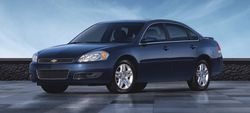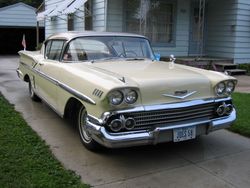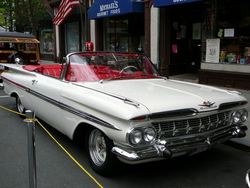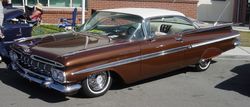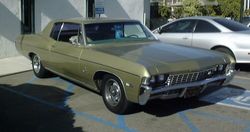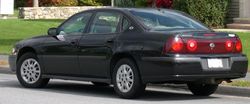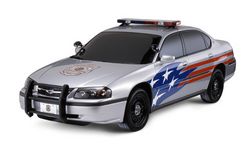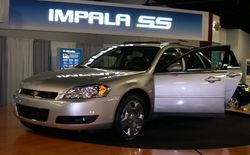.
Chevrolet Impala: Difference between revisions
m (→External links) |
No edit summary |
||
| Line 52: | Line 52: | ||
[[Image:2000-2005_chevrolet_impala_9c1.jpg|left|thumb|250px|2000-2005 Chevrolet Impala 9C1, in police colors]] | [[Image:2000-2005_chevrolet_impala_9c1.jpg|left|thumb|250px|2000-2005 Chevrolet Impala 9C1, in police colors]] | ||
The Impala name was resurrected for the 2000 model year to replace the [[Chevrolet Lumina|Lumina]]. It was built at the Oshawa Car Assembly in Oshawa, Ontario, Canada. Unlike the earlier Impalas, this one was [[front wheel drive]] and was only available with a [[V6|V6]]. This car was based on the GM W platform; 16 inch rims were standard equipment. A new Impala SS with a [[supercharger|supercharged]] [[V6|V6]] was brought out for the 2004 model year. Despite a lower price, the Impala competes with the [[Honda Accord]], [[Toyota Camry]] and other mid-size sedans. | The Impala name was resurrected for the 2000 model year to replace the [[Chevrolet Lumina|Lumina]]. It was built at the Oshawa Car Assembly in Oshawa, Ontario, Canada. Unlike the earlier Impalas, this one was [[front wheel drive]] and was only available with a [[V6|V6]]. This car was based on the GM W platform; 16 inch rims were standard equipment. A new Impala SS with a [[supercharger|supercharged]] [[V6|V6]] was brought out for the 2004 model year. Despite a lower price, the Impala competes with the [[Honda Accord]], [[Toyota Camry]] and other mid-size sedans. | ||
This generation of the Impala (as well as the next generation) became a huge sales success, outselling its competitor, the [[Ford Taurus]]. 290,259 were sold in 2004, making the Impala the third best-selling car in the United States that year. | This generation of the Impala (as well as the next generation) became a huge sales success, outselling its competitor, the [[Ford Taurus]]. 290,259 were sold in 2004, making the Impala the third best-selling car in the United States that year. | ||
Revision as of 11:09, 16 August 2006
The Chevrolet Impala is an automobile developed and built by the Chevrolet car division of General Motors. Ed Cole, Chevrolet's chief engineer in the late 1950s, defined the Impala as a "prestige car within the reach of the average American citizen." At its peak sales volume in 1965, the Impala was the best selling full-size car in the United States.
Impala showcar
The Impala name was first used for the Corvette-based dreamcar for the 1956 General Motors Motorama. Many Chevrolet models originated as Corvette-based experiments; examples include the Corvair and Nomad. The Impala originated as a sports coupe, and was the least Corvette-like of the few because of its purported role. Painted emerald green metalic, with a white interior, the Impala featured hardtop styling.
1958–1972
The Impala was introduced in 1958 as a new up-level, sporty trim package created for Bel Air coupes and convertibles. Unique to the model were its six taillights, a classic styling cue that became its trademark. It was named for a southern African antelope. The Impala became a separate model in 1959 in both two and four-door versions and became the best selling car in the Chevrolet product line. For 1960, it became the best-selling automobile in the United States and held that position for the next decade. From 1958 until 1996, Impala sales were in excess of 13 million units, more than any other full-size car in the history of the automobile. In 1965, the Impala set an all-time industry annual sales record of more than 1 million units, which has never been bettered.
In 1965, Chevrolet introduced the Impala Caprice. Beginning with the four-door hardtop sedan body, Impala Caprice's received unique upholstery, wood grained accents on the dash board and specialty pulls on the insides of the doors. A one year model, the Impala Caprice was reintroduced as the Chevrolet Caprice in 1966, taking the top position in the Chevrolet lineup. The Impala however, remained Chevrolet's top-selling model until late 1970s. During the 1969 model year, for example, Impala production topped Caprice production by 611,000 units.
The 1971 redesign introduced the largest Impala. The Impala's chassis would not be this extensively changed again until the introduction of the 2000 Impala. The Impala would remain Chevrolet's best-selling model until 1977.
Impala SS
The Impala is often credited with starting the muscle car era, although the credit for that really goes to Pontiac when it released the GTO. In the 1960s, gasoline was cheap and consumer demand for power exceeded the need for efficiency. Buyers were clamoring for as much room, performance, amenities and quality as they could get for their dollars. Afraid it would lose out to an in house competition, Chevy released its muscle car, the SS, soon after. In 1961, the Impala SS (Super Sport) was introduced to the market. The SS badge was to become Chevrolet's signature of performance on many models, though it has often been an appearance package only. The Impala's SS package in 1961 was truly a performance package, beginning with the high-performance 348 in³ (5.7 L) engines (available with 305, 340, and 350 hp (230, 255 and 260 kW)) or the new 409 in³ (6.7 L), which was available with up to 425 hp. The package also inclued upgraded tires on station wagon wheels, springs, shocks and special sintered metallic brake linings. Starting in 1962, the Impala SS could be had with any engine available in the Impala, right down to the 235 in³ 135 hp inline-6. With one exception, from this point until 1969, the SS was an appearance package only, though the heavy-duty parts and big engines could still be ordered.
The exception was the Z24 option package available in combination with the standard Z03 Super Sport package. Starting in 1967, through 1969, buyers of Z24s Impalas got cars badged as "SS427" models. The SS427 included heavy duty suspension and other performance goodies, as well as a Turbo-Jet 427 in either L36 or L72 variations. Special SS427 badging inside and out were the rule, but few were sold, since "muscle car" enthusiasts were looking toward big-block intermediates like the Chevelle SS396 and Plymouth Hemi Roadrunners, which were lighter and subsequently faster off the line. Interestingly, Z24 cars could be ordered without the Z03 SS package, which meant SS427 equipment but no bucket seats or center console.
The Impala SS could be identified by SS emblems on the rear fenders and trunk lid. The Impala SS became its own series (separate model rather than an option package) for 1964. In 1968, the Impala SS once more became an option package rather than having its own model. In 1969, the Impala SS again became a performance option, coming only with a 427 in³V8 of 390 or 425 hp. This was the final year for the Impala SS until 1994.
1973–1985
The 1970s showed a change in the American view of the automobile. The impact of the 1973 energy crisis on the industry was dramatic. Gasoline prices doubled between 1973 and 1979. Industry car sales plummeted 20% between 1973 and 1974, and for the first time in recent history, annual passenger car travel in the U.S. actually went down. The Impala's sales dropped to 176,376 units in 1975, the weakest sales year since its introduction in 1959.
This change in the automobile market resulted in Chevrolet redesigning the Impala once again in 1977 to meet changing demands. The new Impalas were shorter in length, taller in stature and narrower. The Impala embodied the new image of the full-size American car — smaller, lighter, more efficient. Even with its trimmer dimensions, the new Impala featured increased headroom, legroom and trunk space. Production of the downsized model increased substantially versus 1976, and the full-size Chevrolet regained the number one US sales position. Unfortunately there were no hardtops or convertible in the "New Impala" series, all cars were pillared sedans.
1994–1996
In 1991, the GM B platform was extensively redesigned, though it retained the same shortened frame design of the 1977 Impala.
The Impala SS badge was resurrected in 1992 as a concept car designed by GM designer John Moss, which received lavish praise of media and auto enthusiasts alike in 1992. In fact, the show car had been so well received that it was put into production almost exactly as the designer of the car had intended, the only noticeable change being the "bowtie" logo on the grille was chrome in the production cars vs. red in the concept. The 1994 Impala SS went into production 14 months later at GM's plant in Arlington, Texas.
The car was a high-performance version of the Caprice, and is often regarded as one of the best all-around cars that General Motors ever produced. From a mechanical standpoint, it used the Caprice 9C1 police package as its base and as such got most of the equipment formerly available only to law enforcement and government agencies. This included a sport-tuned suspension with reinforced shocks and struts, a high-capacity upgraded cooling system, larger and more powerful four wheel disc brakes, transmission cooler, dual exhaust, a higher-output electrical system, and other minor mechanical alterations. Not all of the police equipment was carried over however, and the Impala SS did not get the external oil-to-air engine oil cooler, nor were all the body mounts secured (the standard Caprice and Impala SS were assembled at the factory with the front 3 body mounts missing one of the rubber cushions, while the 9C1 was assembled with all rubber cushions in place), although both are popular aftermarket additions to the Impala SS by their owners.
The Impala SS was uniquely fitted with a 3.08 limited-slip rear differential and suspension that was an inch lower. A retuned LT1 5.7 L small-block V8 engine was standard on the Impala SS, making 260 hp and 330 ft·lbf (447 N·m) of torque. The main difference between the LT1 in the Impala and the LT1 that was in the Corvette and Camaro was that the Impala engine was fitted with cast-iron cylinder heads instead of aluminum ones, and a camshaft that was designed more for low-end torque than high-end horsepower.
Cosmetically, the Impala SS received body-colored trim, which helped reduce the sometimes "bloated" look of the standard Caprice, a unique single-bar grill with no hood ornament, a rear deck spoiler, and for 1994, a rear quarter panel window insert that bore the Impala logo. It was fitted with 17" brushed aluminum rims which wore some surprisingly wide 255 mm Z-rated tires. Inside, the car came with a central console with cup holders (1994 and 1995 models) and a storage compartment, leather seats embroidered with the Impala SS logo, and a standard leather-wrapped steering wheel.
The Impala SS proved to be one of GMs most successful limited-edition vehicles ever. For the 1994 year, it was available only in black with a grey interior and sold a total of 6,303 units. In 1995, Dark Cherry Metallic and Dark Grey Green were added as exterior color options, and the body paneling on the rear quarter panel was altered to reflect the cosmetic effect formally achieved by a window insert. A total of 21,434 cars were sold for the 1995 year. 1996 was the last year of production, and sold 41,941 units. It saw some minor interior alterations, with the digital speedometer being replaced by an analog one, along with a tachometer. The shifter was moved from the column to the center console, and mechanically, the car now used the OBD-II computer system.
The entire B/D-body line, consisting of not only the Caprice and Impala, but the Caprice wagon, Buick Roadmaster and Cadillac Fleetwood, was cancelled by General Motors, as they wanted more of their assembly lines to be able to produce SUVs, which were more profitable for GM. Another fact was that the Caprice was the only B-body with a market share since fleet sales to law enforcement outnumbered sales of other B-bodies. A majority of law enforcement agencies preferred the Caprice over the Ford Crown Victoria.
Today, 1994-1996 Impala SS's retain a great deal of popularity and devotion among owners and enthusiasts, more so than many comparable vehicle models with such a limited production run. Several car clubs across the United States and in other countries are centered around the Impala and related B-body vehicles, such as the Caprice and Buick Roadmaster. The Impala and its cousins are often modified by many of their owners, who take advantage of the powerful Corvette-derived engine and large size of the vehicle.
2000-2005
The Impala name was resurrected for the 2000 model year to replace the Lumina. It was built at the Oshawa Car Assembly in Oshawa, Ontario, Canada. Unlike the earlier Impalas, this one was front wheel drive and was only available with a V6. This car was based on the GM W platform; 16 inch rims were standard equipment. A new Impala SS with a supercharged V6 was brought out for the 2004 model year. Despite a lower price, the Impala competes with the Honda Accord, Toyota Camry and other mid-size sedans.
This generation of the Impala (as well as the next generation) became a huge sales success, outselling its competitor, the Ford Taurus. 290,259 were sold in 2004, making the Impala the third best-selling car in the United States that year.
Impalas, like the Taurus, were popular with fleets, especially for taxicab usage. Some cab companies would fit aftermarket replica hubcaps similar in design to the Ford Crown Victoria once the vehicles were fitted for taxicab use.
For the last year of this generation, 2005, the Impala's daytime running lights were switched from high-beam to low-beam.
Police Package
Also released with this version was the Police Package and Undercover Police Package, named 9C1 and 9C3, respectively. Available only to law enforcement, it has had more success then its predecessor, the Lumina 9C1.
2006-present
The 2006 Impala was introduced at the 2005 Los Angeles Auto Show. The base engine is a 3.5 L V6 producing 211 hp. The most notable news about the model, though, is the SS model's use of the Generation IV small-block V8 in a front wheel drive Chevrolet car for the first time: The new 5.3 L V8 (with Displacement on Demand) will produce 303 hp. The car is 200.4 in (509 cm) long, 58.7 in (149.1 cm) high, and 72.9 in (185.2 cm) wide. Like the Buick LaCrosse, this model uses the updated GM W platform. The 2006 Impala also bears resemblence to the Ford Fusion and Honda Accord. Available trim levels are LS, LT, LTZ and SS. Also updated are the 9C1 & 9C3 trim levels for Police Package models, which do not have the civilian SS' 303 hp V8 engine available, much to the disappointment of law enforcement. This car was panned by the critics who expected the second generation front-wheel drive Impala to have a more aggressive look. For one, to compete with the massive sales volume of the Toyota Camry and Honda Accord and secondly, because it had a more recognized name, legacy, and fan-base larger than Camry and Accord combined. When introduced, it looked like a rehashed Lumina (which was dull in its heyday).
The interior was also completely revised. The 2006 Impala features a new wood trim center console with chrome accents on all major control buttons. The dashboard features a chrome Impala logo embeded in the wood grain trim which runs across the front of the vehicle and onto the doors. The new control knobs found throughout the vehicle's cockpit are similar to those found in the new Buick models as well as the Cadillac DTS, all of whom feature a similar center console. Another interior revision are the cupholders which are now concealed underneath the mid-section of the vehicle's center console.
Awards
The 2006 Impala was selected as Fleet car of the Year by Automotive Fleet and Business Fleet magazines.
2007
The Impala receives several new colors, and an AFM-equipped 3.9 V6 for 2007.
2009
It is speculated that the Impala will be redesigned on the RWD GM Zeta platform.
{{Chevrolet}}
See also
External links
- Official websites: U.S.A. | Canada
- ImpalaSSForum
- Muscle Car Facts - Chevy Impala SS — A year-by-year history
- RoadTests.com - Chevrolet Impala
References
- Template:Citation/core{{#if:|}}
- {{#if:
Biel
|{{#if:
John Biel
|[[{{#if:John Biel
|John Biel
|Biel{{#if:
John
|, John
}}
}}|Biel{{#if:
John
|, John
}}
]]
|Biel{{#if:
John
|, John
}}
}}{{#if:
|{{#if:
|,
| &
}}{{#if:
|[[{{#if:{{{Authorlink2}}}
|{{{Authorlink2}}}
|{{#if:|, }}
}}|{{#if:|, }}
]]
|{{#if:|, }}
}}{{#if:
| & {{#if:
|[[{{#if:{{{Authorlink3}}}
|{{{Authorlink3}}}
|{{#if:|, }}
}}|{{#if:|, }}
]]
|{{#if:|, }}
}}{{#if:
|, et al.
}}
}}
}}
|…
}} (2005){{#if:
Collectible Automobile
|{{#if:
A Glass Half Full: The Story of the 1958 Chevrolet
|, {{#if: http://auto.consumerguide.com/product/collectible/index.cfm
| "A Glass Half Full: The Story of the 1958 Chevrolet"
| "A Glass Half Full: The Story of the 1958 Chevrolet"
}}
}}, Collectible Automobile{{#if:
21
|, vol. 21
}}{{#if:
6
|, no. 6
}}{{#if:
8-23
|, pp. 8-23
|{{#if:
|, p. {{{Page}}}
}}
}}{{#if:
|, {{{ID}}}
}}
|{{#if:
|, {{#if: http://auto.consumerguide.com/product/collectible/index.cfm
| "{{{Contribution}}}"
| "{{{Contribution}}}"
}} in {{#if:
|{{{Editor}}}, ed.,
}}A Glass Half Full: The Story of the 1958 Chevrolet{{#if:
| ({{{Edition}}} ed.)
}}{{#if:
|, {{{Place}}}
}}{{#if:
|{{#if:|: |, }}{{{Publisher}}}
}}{{#if:
|, ISBN {{{ISBN}}}
}}{{#if:
8-23
|, pp. 8-23
|{{#if:
|, p. {{{Page}}}
}}
}}
|{{#if:
A Glass Half Full: The Story of the 1958 Chevrolet
|, {{#if: http://auto.consumerguide.com/product/collectible/index.cfm
| A Glass Half Full: The Story of the 1958 Chevrolet
| A Glass Half Full: The Story of the 1958 Chevrolet
}}
}}{{#if:
| ({{{Edition}}} ed.)
}}{{#if:
|, {{{Place}}}
}}{{#if:
|{{#if:|: |, }}{{{Publisher}}}
}}{{#if:
|, ISBN {{{ISBN}}}
}}
}}
}}{{#if:
| [{{{Access-date}}}]
}}.
- Pages containing cite templates with deprecated parameters
- Templates
- Chevrolet vehicles
- 1958 introductions
- Flagship vehicles
- Front wheel drive vehicles
- Full-size vehicles
- Mid-size cars
- Rear wheel drive vehicles
- 1950s automobiles
- 1960s automobiles
- 1970s automobiles
- 1980s automobiles
- 1990s automobiles
- 2000s automobiles
- Vehicles with front bench seating
